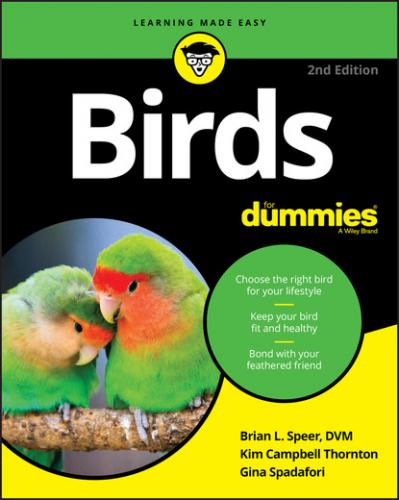Paying attention to price
The price of a pet bird can be considerable, starting from less than $20 for some small budgies or finches and climbing rapidly into the hundreds of dollars for some of the large common parrots and into the thousands and tens of thousands for species that are especially rare, large, or difficult to breed in captivity.
PET PREFERENCE: CUDDLE-BUG, “WILD” THING, OR BREEDER?
Most of the birds commonly available as pets today are valued as much for their companionship as anything else. Socialized, hand-raised babies grow up thinking humans are pretty cool, and they want us to be a member of their flock. We become their family!
The new emphasis on companionship of the pet bird reflects a change in the way many people interact with their birds. In this regard, people often want birds to be family members. Some folks, though, still want birds more to look at than to cuddle, and those people are likely to be happier with birds content to live in an aviary with little or no human contact. Although these are domestically raised birds, to be sure, they’re typically as little interested in us as their wild-born relatives may be.
A third group, the hobby or professional breeder, may have a different goal altogether. Just like a farmer who cares for the animals she stewards, aviculturists do, too. Often, the intended goal is to allow successful breeding and rearing of young birds. An aviculturist’s sole objective may be to allow their birds to procreate and raise their young. Some breeders want to successfully raise a particular species or subspecies. Others may work to develop new colors or varieties, win prizes at shows, make money (or at least pay the costs of production), and enjoy the intense joy and satisfaction that comes from successfully breeding and keeping healthy birds — or all of the above.
What are you looking for in a bird? We talk about the joys as well as the challenges of breeding and raising birds in Chapter 13, and you can find plenty on both the hands-off and hands-on species later in this chapter. But you’re the one who must consider what relationship you’re looking for with your bird, because your decision affects the kind of bird you choose — not just the species, but in many cases the individual bird.
Keep in mind that we’re talking about unique species from a variety of different environments, not simply “breeds of birds.” Our avian friends originate from all around the globe and have evolved to live comfortably and successfully in a particular habitat. When we bring them into our homes to share their lives with us, we have an obligation to think in a species-specific way about what we do with them and for them.
Considering the Species
After you figure out what you want in your feathered companion, you can realistically look at what’s out there and start matching the species that connect with your personality and lifestyle. Don’t feel restricted! The variety of species and types of pet birds available today is so broad that all except the most dedicated quiet-and-neatness types can find more than one species to fill the bill — and probably several!
We put our observations on the record here to let you know what each species is really like, both the good and the not-so-good qualities. Nobody’s perfect — not you, not us, and not any single bird. But getting the match as close as possible is your best bet for a long, happy, and healthy relationship.
The hands-off color and songbirds
Finches — and canaries are finches, too — have been popular for centuries, with
